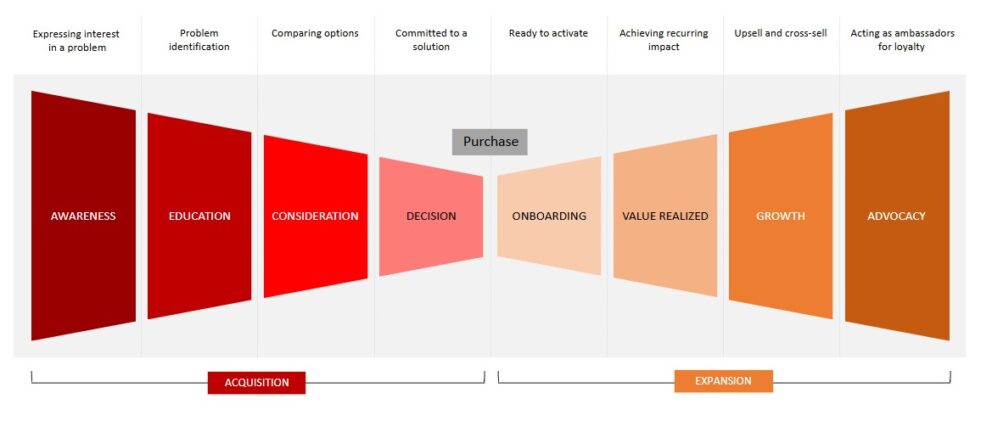Sales and Marketing Alignment Strategies

By Payal Parikh, Director of Client Engagement at Heinz Marketing
What is Sales and Marketing Alignment?
As Matt Heinz says – “there is no sale without marketing and no marketing without sales”. A successful, predictable, and scalable organization doesn’t exist entirely with sales or entirely with marketing. For a greater marketing conversion, you need an efficient sales program. For efficient and more predictable sales, you need a solid marketing program. You need a cohesive approach that includes both sales and marketing.
As more buyers are involved in the purchase decision, extending the length of time it takes to make a decision, a more complex buying journey is created for sellers. For this complex buying journey, a new approach to how go-to-market teams align and coordinate their actions is required. While the marketing and sales teams still need a healthy separation, they need seamless alignment.
A successful revenue generation approach starts by understanding the target accounts and ends with common goals and metrics to track success. This requires alignment between the sales and marketing teams. When the sales and marketing teams are working towards a common goal, are looking at exactly the same data and insights, everyone understands who they are targeting/speaking with, how they are engaging, how much they are engaging, and if the messaging is resonating with their pain points and concerns. Plus, everyone has a common interest in achieving the metrics. It all boils down to having common goals, transparency, and good quality data.
Technology has made it easier for marketers and sellers to work together to identify potential buyers and their buying behaviors. It’s now possible to curate the relevant content and customize the messaging that reaches the buyer based on who they are and where they are in their buying process also called the buyer’s journey. Both sales and marketing teams need to understand the buyer’s motivations and deliver a consistent message.
When sales and marketing align, GTM plans are more effective. Companies observe an increase in revenue through streamlined processes. The sales organization observes a shorter sales cycle. Marketing observes improved conversion rates and better overall GTM plan results.
Sales and Marketing Alignment Strategies
Define a Common Business Goal: When sales and marketing teams have a common goal and are measured on the same KPIs, they have a common interest in achieving the metrics.
Align on Target Audience
While marketing can do the initial research on the companies and titles involved, the sales team can identify the stakeholders involved in the purchase decision. They can identify who has the final authority for the decision, who has the final authority for approving the spend, and who influences the decision making. There will be some stakeholders who have the power to say Yes, some who have the power to say No, some have the power to say both, and some will be influencing the purchase decision.
Align on Personas and Messaging
Buyer Personas define who the target audience is and what their pain points are, which isn’t just valuable to marketing; they also educate sales on who they’re selling to, what they care about, and how to help them. Consider your buyer personas when you are developing your marketing and sales materials. We, at Heinz Marketing, cannot reinforce the importance of sales enablement enough. We help develop an integrated GTM plan which talks to the relevant audience, delivers the relevant message, and creates an alignment between sales and marketing with a sales enablement strategy. Overall, it delivers a better buyer experience.
Set up a reporting and meeting cadence
Having common goals and KPIs is important, but meeting regularly and monitoring the KPIs on a regular basis helps keep the alignment intact. This also provides an opportunity to brainstorm and discuss how the follow-ups are working. This weekly regular platform provides an opportunity to understand and adjust prospect pain points, what kind of messaging is resonating, and what content needs to be produced. It is a reality check on the quality of leads.
Clearly define roles and responsibilities
For successful sales and marketing alignment, it is important to clearly define the roles and responsibilities of each team and team member. Identify who is responsible for communicating the overall plan, who is responsible for providing sales enablement materials, and who is responsible for follow-ups. There should also be a clear understanding of reporting and weekly status updates.
Why does it have to come from the top?
Culture changes take time and require alignment at the very top of the organization. If sales and marketing alignment isn’t an executive priority, it simply won’t stick. Executive sponsorship of this alignment drives more velocity, greater efficiency, and better results. True alignment does not happen at the sales kick-off, it happens via the tactics, processes, and habits that connect the two groups on a daily basis.






